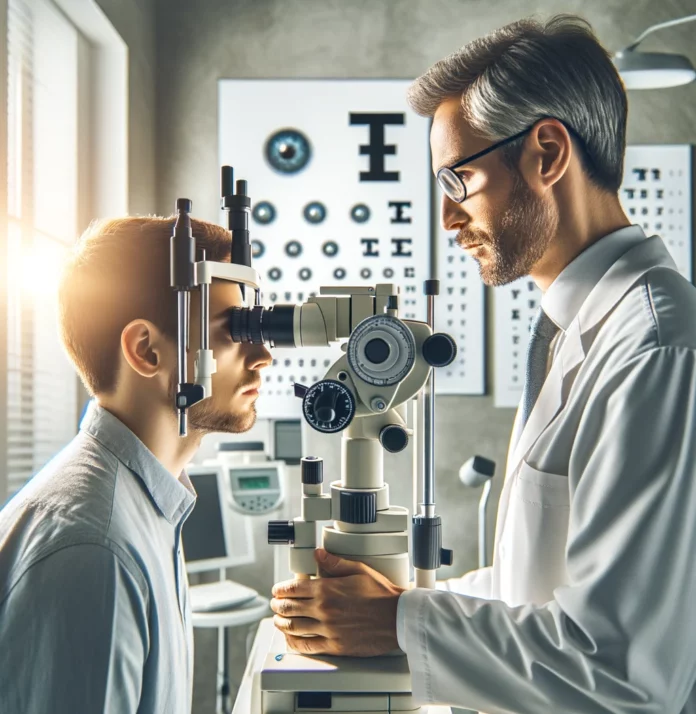Futurists often painted healthcare as an industry that robots have replaced. Even now, as medical innovation races forward, especially with the adoption of AI technologies, the role of doctors might seem destined to dwindle. Yet, the reality is the opposite. Technologies pave the way for deeper doctor-patient connections and more expansive care access.
Let’s explore the reality-based future of ophthalmology.
The first thing to consider is a dramatic shift in global demographics. Due to improving general healthcare, lifespans are longer, with the proportion of older adults increasing. This tendency translates to a surge in age-related eye conditions. Cataracts, diabetic retinopathy, glaucoma, and age-related macular degeneration will become more prevalent.
Even more significant is how technology, specifically ophthalmology AI, is already revolutionizing early detection and diagnosis.
AI identifies pathologies at their developing stages by accurately analyzing vast amounts of medical data. While this is a positive thing, it will increase the number of patients seeking care.
There are already innovations that can significantly help people struggling with heavy diagnoses, such as smart lenses and bionic eyes. Recent evolution in corneal transplantation techniques is also revolutionizing the field of vision restoration. Traditional transplants are being surpassed by minimally invasive procedures. They involve selective replacement of only the damaged inner layer of the cornea, resulting in quicker visual recovery, reduced risk of rejection, and improved long-term outcomes. But the solutions still have a drastic downside. While holding the potential to improve lives, they carry hefty price tags.
It does not help that many eye problems are linked to other conditions, like diabetes. So, for example, individuals with diabetes, a demographic already bearing a significant financial burden, will require continuous glucose monitoring through smart lenses. And while this technology is revolutionary, its affordability becomes a crucial question. Similar concerns surround bionic eyes that offer hope to individuals with severe vision loss. So, automating tasks in medicine through AI to make it less expensive is essential to making eye care more affordable.
One technological advancement that is meant to expand the reach of ophthalmology to make it more accessible is telemedicine. Patients living in remote areas or facing mobility challenges who were previously excluded from proper eye care will gain access through virtual platforms.
In addition to this progress, another crucial aspect is the integration of personalized medicine approaches. With genetic testing and tailored treatment plans, ophthalmologists can offer more targeted interventions for patients with complex eye conditions. By understanding everyone’s unique genetic makeup and disease profile, doctors can optimize treatment efficacy This personalized approach not only enhances patient outcomes but optimizes healthcare resources by avoiding unnecessary treatments.
Summary
The post outlines a future where technology, particularly AI, enhances the field of ophthalmology, contrary to fears of diminishing the role of doctors. With the aging global population leading to a rise in age-related eye conditions, AI’s role in early detection and diagnosis is crucial. Innovations such as smart lenses, bionic eyes, and advanced corneal transplantation techniques are revolutionizing patient care but also raise concerns about affordability, especially for patients with additional health conditions like diabetes. Telemedicine and personalized medicine approaches are highlighted as key to making ophthalmological care more accessible and tailored to individual needs. Ultimately, the future of ophthalmology is seen as a blend of technological advancement and the irreplaceable human touch of doctors, fostering deeper connections with patients and improving care access and effectiveness.
Related Interests
Given the advancements in ophthalmology and healthcare technology, people are exploring several related areas:
- Wearable Health Tech: Beyond smart lenses, there’s growing interest in wearable devices that monitor health metrics in real-time, offering insights into heart rate, sleep patterns, and physical activity, aiming to preemptively address health issues.
- AI in Other Medical Fields: AI’s impact on ophthalmology piques interest in its application across other medical specialties, such as oncology for early cancer detection and cardiology for heart disease prediction.
- Healthcare Accessibility Solutions: With telemedicine expanding care access, there’s increased interest in further innovations that bridge geographical and socioeconomic gaps in healthcare, including mobile health clinics and online consultation platforms.
- Genetic Testing and Personalized Medicine: As tailored treatments become more common in ophthalmology, individuals are keen on exploring genetic testing’s role in other areas of health, offering personalized approaches to prevention and treatment based on genetic predispositions.
- Cost-Effective Healthcare Innovations: The concern over affordability leads to interest in policies and technologies that reduce healthcare costs without compromising quality, such as generic medication markets, healthcare subsidy programs, and cost-sharing models.
These related interests reflect a broader trend towards integrating technology in healthcare to improve outcomes, accessibility, and personalization, while also addressing challenges such as cost and the importance of maintaining the human element in patient care.

